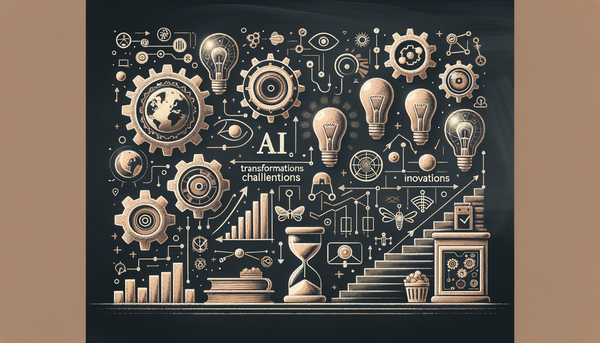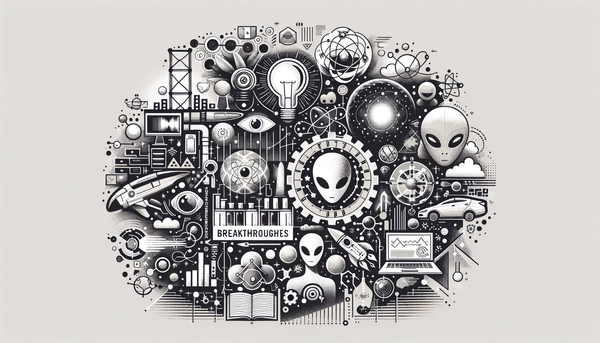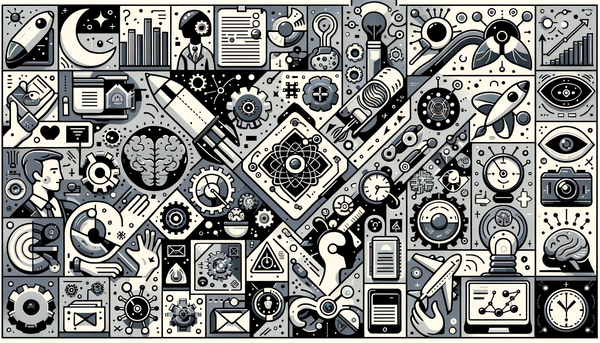AI and Healthcare Security: Friends or Foes?
In this comprehensive exploration, we delve into the explosive growth of artificial intelligence applications across biotechnology, healthcare security, and high-performance computing. We analyze how AI’s integration is revolutionizing drug discovery and genomics, transforming security protocols in healthcare, and powering cutting-edge edge computing platforms, all while highlighting the intersections between business innovation and emerging technology trends.
AI Revolutionizing Biotechnology: A Glimpse into the Future
The biotechnology market is undergoing a remarkable transformation with artificial intelligence at its helm. Recent analyses, such as the article from Yahoo Finance, reveal exciting projections with the market expected to reach a staggering USD 20,036 million by 2034. This projection is not an isolated number but a reflection of the revolutionary potential that lies in the convergence between machine learning and biological sciences. Using advanced algorithms, biotech companies are able to process enormous volumes of biological data, thereby expediting drug discovery, speeding up clinical trials, and even tailoring treatments for individualized care.
Historically, the pace of innovation in biotechnology relied heavily on trial and error, and laboratory experiments that could take months or even years. Today, the integration of AI has led to a paradigm shift. Machine learning algorithms can mine genetic data and identify patterns that would be imperceptible to traditional research methods. This not only accelerates the discovery of promising drug candidates but also significantly enhances the precision of medical interventions. Companies are leveraging AI in genomics to predict disease susceptibility, customize treatment protocols, and even anticipate potential side effects, thereby offering a more holistic approach to patient care.
One can draw parallels with the industrial revolution—when mechanization defined new horizons in manufacturing, AI is now redefining the landscape in biotech. As quoted by Stephen Hawking, "AI is a tool, not a replacement for human intelligence." This sentiment rings especially true in biotechnology, where the synergy between human expertise and machine efficiency is paving the way for groundbreaking medical advancements.
Real-World Implications in Biotech
Consider a scenario where an AI algorithm analyzes thousands of genomic sequences across diverse populations. This data-driven approach can lead to discovering genetic markers indicative of responsiveness to specific drugs. Consequently, pharmaceutical companies can design more effective clinical trials. Beyond the lab, this translates into faster access to life-saving treatments for patients and could even help tackle global challenges like pandemics with unprecedented speed.
For businesses and investors, this growth represents a dynamic opportunity. Leading biotech firms are not merely automating routine procedures; they are using AI to uncover insights that were once thought unattainable. Although the technological landscape continues to evolve rapidly, the promise of improved precision in drug development and personalized medicine remains a tantalizing prospect for both the scientific community and the broader healthcare market.
Many in the industry see this AI-driven convergence as a beacon for the future. Anecdotes of researchers who once spent years sifting through experimental data are now routinely replaced with powerful, AI-enabled platforms that accomplish in hours what once took life-long efforts. The evolution of AI in biotechnology also highlights the need for ongoing collaboration between data scientists, biologists, and healthcare professionals to ensure that the technology is applied ethically and effectively.
The Dual Role of AI in Healthcare Security
In the realm of healthcare, artificial intelligence plays a complex dual role when it comes to security. An article recently highlighted on Dark Reading explores the paradoxical nature of AI in healthcare security. On one side, AI stands as a bulwark against cyberthreats, enhancing the ability to detect and mitigate risks swiftly. On the other side, the very capabilities of AI can be exploited by malicious actors, paving the way for sophisticated cyber attacks.
The healthcare sector, inherently sensitive due to the vast amounts of personal patient data it holds, is a prime target for cybercriminals. AI systems are now being deployed to monitor network traffic, flag unusual behaviors, and predict potential vulnerabilities. These systems can rapidly analyze logs and user activities, making them invaluable in promptly identifying threats. For instance, algorithms can detect anomalies in login patterns or rapid, unexpected changes in data access, which might indicate a breach.
"The pace of progress in artificial intelligence is incredibly fast." — Elon Musk
Yet, for every benefit, there’s an inherent risk. The sophisticated nature of AI technology means that if it falls into the wrong hands, cybercriminals can use it to learn from security systems and develop even more advanced methods of attack. This evolving dynamic essentially creates an arms race in cybersecurity, where defenders and attackers continually adapt to each other’s innovations.
Healthcare providers are now confronted with new ethical and technical challenges. On the defensive end, organizations must adopt robust cybersecurity measures not only to prevent traditional cyberattacks but to counter potential AI-driven intrusions. There is a growing need for integrated platforms that can both detect and predict harmful activities using real-time data analysis.
This delicate balance is reminiscent of the proverbial double-edged sword. The integration of AI into healthcare security systems is both transformative and treacherous. As security infrastructures become more reliant on AI, legacy systems risk being outpaced, necessitating urgent upgrades and continuous monitoring. Fostering strong partnerships between healthcare IT teams and cybersecurity experts has therefore become crucial.
Lessons from the Field and Future Directions
To mitigate these dual threats, hospitals and medical institutions are actively investing in AI-enabled security systems that incorporate constant learning and adaptation. Practical implementations have been observed where AI-driven anomaly detection software preemptively isolates potential threats, thus curtailing the window of opportunity for cybercriminals. Managed security services are becoming an essential part of IT strategy in healthcare, evolving to include AI threat analytics and response strategies shortly after each incident is detected.
Moreover, industry leaders are increasingly advocating for a comprehensive cybersecurity framework that integrates AI, traditional security practices, and human oversight. This multi-layer defense strategy is perceived as the most effective approach to countering both known and emerging cyber threats. An illustrative case is the collaborative effort between cybersecurity firms and healthcare institutions, resulting in the joint development of resilient security measures designed to adapt to continuously evolving threats.
Collegial discussions in various forums and research circles consistently underline that while AI technology introduces vulnerabilities, it simultaneously equips healthcare services with the tools necessary to respond promptly to breaches. Innovative research in this domain is paving the way for a future where AI could predict potential cyber incidents before they occur, thus safeguarding patient data more effectively.
This evolution in strategy is underscored by evidence from multiple studies, which indicate that when healthcare organizations harness AI as a tool for cybersecurity, overall data integrity and patient trust experience a significant uplift. As we look forward to the future, the interplay between AI’s defensive capabilities and its potential for misuse will undoubtedly shape the security landscape in healthcare.
Empowering Next-Generation Computing: HPE Gen12 ProLiant Servers and the Edge
Shifting our focus to the realm of high-performance computing, Hewlett Packard Enterprise (HPE) has unveiled its Gen12 ProLiant servers, a robust suite of machines designed to empower AI processing and edge computing. As covered by The Next Platform, these servers are optimized not just for speed but for unparalleled efficiency and real-time data analysis, making them an essential component in the era of intelligent computing.
Edge computing represents a significant departure from the traditional model where processing is centralized in data centers. Instead, computations occur closer to the data source. This paradigm shift is particularly beneficial when applying AI algorithms that require immediate analysis of data with minimal latency. HPE’s Gen12 servers are engineered to meet these demands, seamlessly managing complex tasks across distributed networks. With the processing power packed into these systems, organizations are now able to execute real-time analytics, machine learning, and automated decision-making processes at the very edge of their networks.
The benefits of such capabilities extend across industries. In industrial manufacturing, for example, edge computing allows for swift adjustments in production lines based on sensor data. In retail, AI-powered analytics at the edge can drive instant insights into consumer behavior, prompting real-time marketing adjustments. Even in healthcare, edge computing is making waves by enabling the rapid processing of patient data during critical moments, thereby facilitating immediate and informed decision-making.
The Convergence of AI and High-Performance Computing
The introduction of Gen12 ProLiant servers marks a significant leap forward, building on years of innovation in both hardware and software. These servers exemplify the ongoing trend of integrating AI directly into the fabric of computing infrastructure. As data demands escalate and real-time insights become more valuable, the need for edge computing has grown exponentially. HPE’s innovative approach is setting new benchmarks for what’s possible in distributed computing environments.
The seamless fusion of AI algorithms with high-performance hardware is a game changer. It provides businesses with the groundwork to not only process large datasets swiftly but also to build predictive models that enhance operational efficiency. Consider the scenario of a manufacturing plant that deploys sensors throughout its facility: real-time monitoring coupled with AI analysis can detect breakdowns before they occur, translate into significant cost savings, and optimize production throughput.
This kind of technological empowerment mirrors the evolution seen in many sectors over the years—a shift from centralized, slower processes to dynamic, on-the-fly analytics. With such capabilities now in hand, industries are poised to make more agile decisions, thereby driving economic and operational efficiency at unprecedented scales.
From a strategic viewpoint, the push towards edge computing is aligned with broader trends in digital transformation seen on platforms like AI.Biz. Business leaders and technology enthusiasts alike echo similar sentiments: as AI takes root in everyday applications, the fusion of real-time, edge-based processing becomes not simply an advantage but a necessity in today's hyper-connected world.
Integrative Reflections on AI’s Multifaceted Impact
As we integrate these insights from biotechnology, cybersecurity, and high-performance computing, a common thread becomes evident: the transformative influence of AI across diverse industries. Whether it’s the enhanced precision in bioinformatics, the delicate balancing act in securing patient data, or the push for decentralized processing through edge computing, AI is redefining the boundaries of what is technologically possible.
This multidimensional progression is both exciting and humbling. Every breakthrough brings with it enormous opportunities, yet each technological marvel also presents important questions about ethics, security, and long-term sustainability. Many experts have argued that maintaining a robust dialogue between AI innovators, ethicists, and industry leaders is indispensable. True progress, after all, requires a balance between rapid advancements and slower, contemplative regulation and oversight.
For those on the front lines of research and development in AI, the challenges are as significant as the rewards. A responsible approach involves not only focusing on short-term gains but also anticipating potential long-term impacts. For example, while the integration of AI in drug discovery can significantly speed up treatment developments, it should come hand in hand with considerations regarding data security and ethical approval processes.
The evolving relationship between AI and human cognition also invites deeper philosophical inquiry. As Sherry Turkle once remarked, "AI is a reflection of the human mind—both its brilliance and its flaws." This reflection is evident in every step forward in biotechnology breakthroughs, cybersecurity innovations, and edge computing advancements. The real challenge lies in harnessing this potential responsibly, ensuring that technological enhancements enhance human capabilities rather than supplant them.
Examples from Everyday Life
Consider a modern hospital where AI-powered imaging scans support faster diagnosis, while parallel cybersecurity layers protect patient records. Here, advanced servers and edge computing technology ensure rapid data processing, which can be the difference between timely intervention and critical delay. Meanwhile, in a pharmaceutical lab, machine learning sifts through petabytes of genomic data to uncover clues that could lead to the next breakthrough treatment. These are not scenarios of the distant future—they are happening now in labs, hospitals, and industrial facilities.
In my own analysis, the future of AI lies in its capacity to link together these dispersed yet interdependent sectors. Achieving a synthesis between biotech innovation, secure networks, and agile edge computing will require robust systems that are flexible enough to evolve as new challenges and opportunities emerge.
Industries around the world are already beginning to see the merits of a connected approach. Digital transformation is no longer about isolated upgrades—it’s about holistic integration. One can view the broad AI revolution as a vast tapestry, where each thread contributes to an intricate design, ensuring that the whole is far greater than the sum of its parts.
Cross-Linking to Broader AI Discussions at AI.Biz
The journey of artificial intelligence is dynamic and interwoven with countless innovations and challenges. For instance, if you’re keen on understanding how AI is metamorphosing patient care and healthcare delivery, you might revisit the detailed discussion on Transforming Patient Care with AI in Healthcare hosted by Sameer Gupta on AI.Biz. His podcast and subsequent discussions shed light on the practical implications of AI in healthcare today.
Similarly, the ongoing exploration of digital landscapes in our modern economy has been eloquently captured in our recent piece on Rethinking the Digital Landscape: AI Challenges and Opportunities. This article takes a broad look at the societal and technical impacts of AI, highlighting both the potential for innovation and the need for thoughtful regulation as the technology continues to advance.
Moreover, the recent updates on various AI innovations and their corresponding challenges, as shared on the AI News Updates portal, offer vital insights into the fast-paced world of AI, examining everything from ethical conundrums to breakthrough advancements in machine learning technologies. These articles collectively illustrate the vast, interconnected ecosystem that AI operates within—a place where security, innovation, and ethical considerations are in constant dialogue.
Looking Ahead: AI’s Continuing Odyssey
The current landscape of artificial intelligence is in a state of perpetual evolution. The convergence of biotechnology, cybersecurity, and high-performance edge computing devices heralds a future marked by rapid advancements and complex challenges. As we move forward, AI will undoubtedly bolster efficiencies, drive innovation, and redefine operational paradigms in virtually every sector of the economy.
It is vital to recognize that while AI exhibits immense potential, its successful implementation relies on a balanced integration of technical capability and ethical foresight. Future research might focus on creating adaptive systems that can learn from both successes and failures, ensuring that AI remains a positive force for societal good.
Embracing AI in its multifaceted forms requires a collaborative effort from researchers, industry leaders, policymakers, and the public alike. By fostering an environment that thrives on innovation, transparency, and accountability, we can reap the benefits of AI while safeguarding against its risks.
To encapsulate, the future of biotechnology, healthcare security, and edge computing is being reshaped by artificial intelligence. As industry experts continue to push boundaries, the integration of AI across these fields offers a glimpse into a future where technology not only supports human endeavors but also elevates them to unprecedented heights. The journey ahead is one of exploration, discovery, and prudent innovation—an odyssey that holds the promise of transforming our world in ways we are only beginning to understand.
In closing, while we celebrate the disruptive breakthroughs made possible by AI, we must remain vigilant about the ethical and security concerns that inevitably accompany such sweeping change. The pursuit of innovation must always be balanced with the responsibility to protect and empower every stakeholder affected by these technological shifts.




